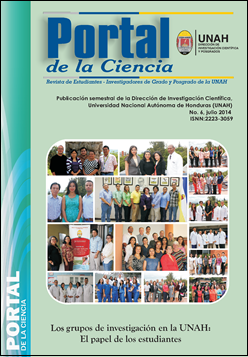Anatomy of the vegetative and reproductive organs and Crescentia Crescentia alata cujete (Bignoniaceae)
DOI:
https://doi.org/10.5377/pc.v6i0.1839Keywords:
Crescentia, anatomy, nectaries, extrafloral, floral, pollenAbstract
Crescentia is a genus that inhabits in dry forests, and Central America the species are considered to have great economic importance. The taxonomic separation of C. alata and C. cujete has been much debated, since both species are closely related. The aim of this study was to determine the vegetative and reproductive anatomy of C. alata and C. cujete. Among the anatomical characteristics observed in both species, are: the presence of periderm and pith with secondary phloem fibers in stems; the leaf has extrafloral nectaries, and in the midrib possess dorsiventral mesophyll with palisade parenchyma and lacune tissue also the vascular cylinder has periphloematics fibers; petals and sepals possess many accumulations of pigment and abundant glandular hairs, floral nectaries and pollen has colpate ornamentation; and the seed has a large amount of endosperm and aleurone layer. In conclusion, both species have similar anatomical characteristics; however, the pollen grains ornamentation is different between the two species in particular, the number of colpus or apertures.
DOI: http://dx.doi.org/10.5377/pc.v6i0.1839
Revista Portal de la Ciencia, No. 6, julio 2014: 27-36
Downloads
2649
Downloads
Published
How to Cite
Issue
Section
License
© Revista Portal de la Ciencia
Los autores/as que publiquen en esta revista aceptan las siguientes condiciones:
De acuerdo con la legislación de derechos de autor, Revista Portal de la Ciencia, reconoce y respeta el derecho moral de los autores, así como la titularidad del derecho patrimonial, el cual será cedido a la revista para su difusión en acceso abierto en versión impresa y en formato digital. Al formar parte de múltiples indexadores, bases de datos y sistemas de referencia, los artículos que sean publicados por Revista Portal de la Ciencia se encontrarán visibles y serán descargados también de estos sitios web, indicando, en todos los casos, la autoría de los artículos, la fecha de publicación y el número de la revista al que corresponden.

Este obra está bajo una licencia de Creative Commons Reconocimiento-NoComercial 4.0 Internacional.
Usted está en libertad de:
- Compartir: copiar y redistribuir el material en cualquier medio o formato
- Adaptar: remezclar, transformar y crear a partir del material
Bajo las siguientes condiciones:
- Reconocimiento: Usted debe darle crédito a esta obra de manera adecuada, proporcionando un enlace a la licencia, e indicando si se han realizado cambios. Puede hacerlo en cualquier forma razonable, pero no de forma tal que sugiera que usted o su uso tienen el apoyo del licenciante.
- Uso no comercial: Usted no puede hacer uso del material con fines comerciales.




